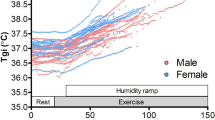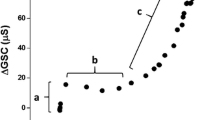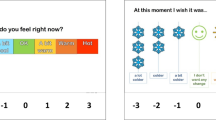Abstract
The purpose of this study was to investigate the distribution of steady-state sweating rates (m sw), during stressful exercise and heat exposures. Six men completed 42-min trials: 2-min rest and 40-min cycling at 40% peak power in 36.6° C (relative humidity 46.0%). The m sw, was monitored using ventilated capsules at the forehead, and at three additional sites. Repeat trials allowed monitoring from eleven skin surfaces. Auditory canal temperature (Tac) and 11 skin temperatures were measured. After normalising m sw to the forehead response within subjects, differences in T ac and onset time thresholds, and transient and steady-state m sw were examined. The pooled, lower torso m sw onset [mean 45.5 (SEM 42.0) s] preceded that of the head [mean 126.5 (SEM 34.8) s, P<0.05], but was not significantly different from the legs [mean 66.6 (SEM 25.7) s], upper torso [mean 80.2 (SEM 36.8) s] or arms [mean 108.6 (SEM 31.2) s]. Transient m sw did not differ among regions (P=0.16). Mean, steady-state forehead m sw [3.20 (SEM 0.51) mg · cm−2 · min−1]was not significantly greater than the scapula, forearm, hand, stomach and lower back m sw (in descending order), but was greater than the chest [1.6 (SEM 0.2)], upperarm [1.6 (SEM 0.2)], calf [1.5 (SEM 0.3)] and thigh m sw [1.0 (SEM 0.2), P<0.05 for all comparisons]. The results did not support the caudal-to-rostral sweat onset evident during supine, resting heat stress. Equivalent T ac sweat thresholds existed between sites, while steady-state m sw topography varied among subjects and was not dominated by central regions.
Similar content being viewed by others
References
Ayling JH (1986) Regional rates of sweat evaporation during leg and arm cycling. Br J Sports Med 20:35–37
Bothorel B, Dewasmes G, Hoeft A, Candas V (1991) Temperature and sweating responses in one-legged and two-legged exercise. Eur J Appl Physiol 63:157–164
Buono MJ, White C, Connolly KP (1991) Pilocarpine-induced sweat rate at rest versus whole-body sweat rate during exercise. J Appl Sport Sci Res 5:82–86
Candas V, Libert JP, Vogt JJ (1983) Sweating and sweat decline of resting men in hot humid environments. Eur J Appl Physiol 50:223–234
Crockford GW, Foster KG, Haspineal J (1971) The influence of exercise on the seating threshold. J Physiol 217:37P-38P
Elizondo RS (1973) Local control of eccrine sweat gland function. Fed Proc 32:1583–1587
Elizondo RS, Bullard RW (1971) Local determinants of sweating and the assessment of the “set point”. Int J Biometeorol 15:273–280
Ferres HM (1960) The effect of pressure on sweating. J Physiol 151:591–597
Hertzman AB (1957) Individual differences in regional sweating. J Appl Physiol 10:242–248
Hertzman AB, Randall WC, Peiss CN, Seckendorf R (1953) Regional rates of evaporation from the skin at various environmental temperatures. J Appl Physiol 5:153–161
Höfler W (1968) Changes in regional distribution of sweating during acclimatization to heat. J Appl Physiol 25:503–506
International Organisation for Standardisation (1992) Evaluation of thermal strain by physiological measurements. ISO 9886: 1992 [E]. ISO, Geneva, Switzerland
Keatinge WR, Sloan REG (1975) Deep body temperature from aural canal with servo-controlled heating of the outer ear. J Appl Physiol 38:919–921
Libert JP, Candas V, Vogt JJ (1983) Modifications of sweating responses to thermal transients following heat acclimation. Eur J Appl Physiol 50:235–246
Mekjavic IB, Rempel ME (1990) Determination of esophageal probe insertion length based on standing and sitting height. J Appl Physiol 69:376–379
Nadel ER, Mitchell JW, Saltin B, Stolwijk JAJ (1971) Peripheral modifications to the central drive for sweating. J Appl Physiol 31:828–833
Ogawa T, Asayama M (1986) Quantitative analysis of the local effect of skin temperature on sweating. Jpn J Physiol 36:417422
Park SA, Tamura T (1992) Distribution of evaporation rate on human body surface. Ann Physiol Anthropol 11:593–609
RandallWC (1946) Quantitation and regional distribution of sweat glands in man. J Clin Invest 25:761–767
Randall WC, Hertzman AB (1953) Dermatomal recruitment of sweating. J Appl Physiol 5:399–409
Regan JM, Macfarlane DJ, Taylor NAS (1994) Adaptation to heat: differences induced by isothermal strain following heat acclimation and thermoneutral exercise. Proc Aust Physiol Pharmacol Soc 25:3P
Roberts DF, Salzano FM, Wilson JOC (1970) Active sweat gland distribution in Chaingang Indians. Am J Physiol Anthropol 32:395–400
Sato K, Dobson RL (1970) Regional and individual variations in the function of the human eccrine sweat gland. J Invest Dermatol 54:443–449
Schvartz E, Bhattacharya A, Sperinde SJ, Brock PJ, Sciaraffa D, Van Beaumont W (1979) Sweating responses during heat acclimation and moderate conditioning. J Appl Physiol 46:675–680
Seckendorf R, Randall WC (1961) Thermal reflex sweating in normal and paraplegic man. J Appl Physiol 16:796–800
Stolwijk JAJ, Nadel ER, Mitchell JW, Saltin B (1971) Modification of the central sweating drive at the periphery. J Biometeorol 15:268–272
Tam H, Darling RC, Downey JA, Cheh H (1976) Relationship between evaporation rate of sweat and mean sweating rate. J Appl Physiol 41:777–780
Van Beaumont W, Bullard RW (1965) Sweating: direct influence of skin temperature. Science 147:1465–1467
Weiner JS (1945) The regional distribution of sweating. J Physiol 104:32–40
Yamazaki F, Sone R, Ikegami H (1994) Responses of sweating and body temperature to sinusoidal exercise. J Appl Physiol 76:2541–2545
Author information
Authors and Affiliations
Rights and permissions
About this article
Cite this article
Cotter, J.D., Patterson, M.J. & Taylor, N.A.S. The topography of eccrine sweating in humans during exercise. Eur J Appl Physiol 71, 549–554 (1995). https://doi.org/10.1007/BF00238559
Accepted:
Issue Date:
DOI: https://doi.org/10.1007/BF00238559




